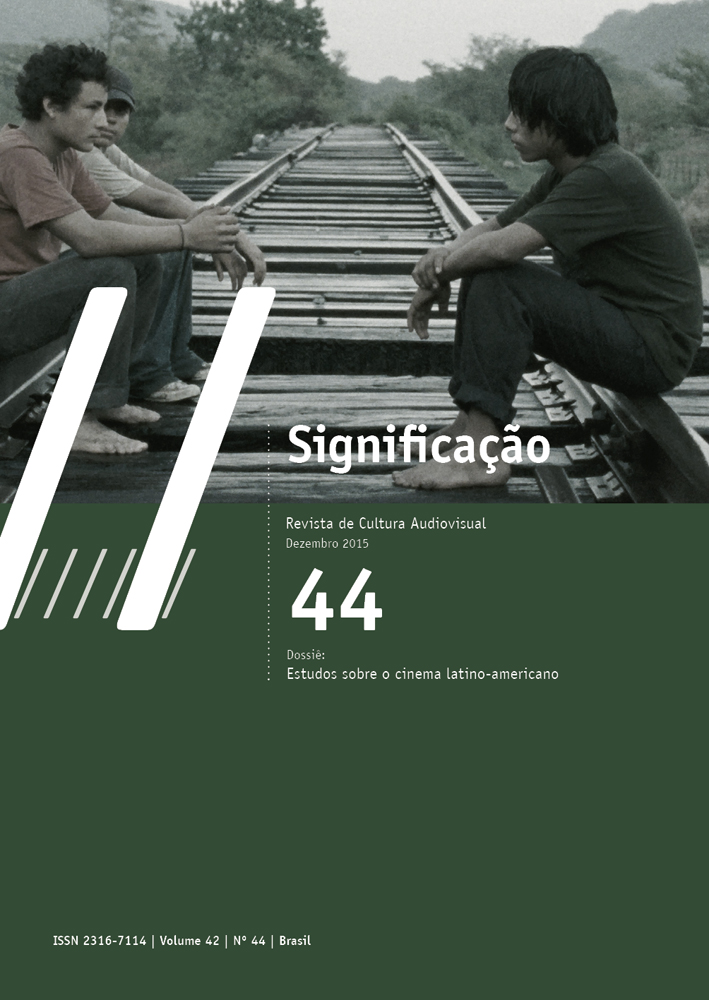Identity and alterity in cinema: significants spaces in contemporary sound poetics
DOI:
https://doi.org/10.11606/issn.2316-7114.sig.2015.103048Keywords:
cinema sound, soundscape, identity, alterityAbstract
Discussions on sound design in cinema go beyond the issue of sound-image synchronization. An example is !lmmaker Lucrécia Martel’s use and elaboration of the soundtrack - mainly in works such as La ciénaga (The Swamp, 2001) and La mujer sin cabeza (The Headless Woman, 2008) -, which establishes a different kind of observation in relation to the space constructed by the soundtrack and evidences other possible readings of the movie. As much as Martel’s work with narrative spaces through sound is unique and bold, emphasizing the importance and the possibility of using this element in the composition of the staging space and in the relationship with the mise en scène, two examples in Brazilian contemporary cinema - Kleber Mendonça Filho’s O som ao redor (Neighboring Sounds, 2013) and Marcelo Lordello’s Eles voltam (They’ll Come Back, 2014) stand out for their use of the soundtrack. Based on the creation of soundscapes that surround the characters, the movies subtly build the concepts of alterity and identity, weaving an interesting interplay of differences and similarities between what is seen (identity) and what is heard (alterity).Downloads
References
Referências
BAKHTIN, M. Estética da criação verbal. São Paulo: Martins Fontes, 2006.
BARTHES, R. O óbvio e o obtuso, ensaios críticos III. Rio de Janeiro: Nova Fronteira, 1982, p. 217-229.
BERGSON, H. Matéria e memória. 4. ed. São Paulo: WMF Martins Fontes, 2010.
BORDWELL, D. “Estudos de cinema hoje e as vicissitudes da grande teoria”. In: RAMOS, F. P. (Org.). Teoria contemporânea do cinema: pós-estruturalismo e filosofia analítica. São Paulo: Senac, 2005, v.1, p. 25-70.
BUHLER, J.; NEUMEYER, D.; DEEMER, R. Hearing the movies: music and sound in film history. New York: Oxford University Press, 2010.
CAMPAN, V. L’écoute filmique: echo du son en image. Paris: Presses Universitaires de Vincennes, 1999.
CAMPO, M. B. “Tempo e História: representação em Lucrecia Martel”. Imagofagia, nº 7 (2013). Disponível em: <http://www.asaeca.org/imagofagia/sitio/index.php?option=com_content&view=article&id=306%3Atempo-e-historia-representacao-em-lucrecia-martel-&catid=50%3Anumero-7&Itemid=150>. Acesso em: 10 maio 2013.
DELEUZE, G. A imagem-movimento. São Paulo: Brasiliense, 1985.
_________. A imagem-tempo. São Paulo: Brasiliense, 1990.
ECO, U. A obra aberta. 9. ed. São Paulo: Perspectiva, 2003.
FLÔRES, V. O cinema: uma arte sonora. São Paulo: Annablume, 2013.
MACHADO, A. O sujeito na tela: modelos de enunciação no cinema e no ciberespaço. São Paulo: Paulus, 2007.
METZ, C. A significação no cinema. São Paulo: Perspectiva, 1977.
PUCCI, R. “Questões de identidade e alteridade”. Impulso, Piracicaba, n. 21, jan-jun. 2011, p. 43-49.
SCHAEFFER, P. Traité des objets musicaux. Paris: Editions du Seuil, 1966.
VERARDI, M. “La ciénaga (Martel, 2001): el tiempo suspendido”. Imagofagia, nº 7 (2013). Disponível em: <http://www.asaeca.org/imagofagia/sitio/index.php?option=com_content&view=article&id=305:la-cienaga-el-tiempo-suspendido-&catid=50:numero-7&Itemid=150>. Acesso em: 17 jul. 2013.
Referências Filmográficas
ELES voltam. Marcelo Lordello, Brasil, 2014.
O SOM ao redor. Kleber Mendonça Filho, Brasil, 2013.
LA CIÉNAGA (O pântano). Lucrecia Martel, Argentina-França-Espanha-Japão, 2001.
LA MUJER sin cabeza (A mulher sem cabeça). Lucrecia Martel, Argentina-França-Itália-Espanha, 2008.
Downloads
Published
Issue
Section
License
Copyright (c) 2015 Virginia Osorio Flôres

This work is licensed under a Creative Commons Attribution-NonCommercial 4.0 International License.
Authors who publish in this journal must agree with the following terms:
- Authors keep their copyrights and grant the journal first time publication rights, having their articles simultaneously licensed under the Creative Commons Attribution License, which allows sharing texts with authorship recognition and first publication on this journal for non-commercial purposes.
- Authors are allowed to make additional contracts, for a non-exclusive distribution of the article’s version published on this journal (e.g.: publishing in institutional repositories of articles or as a book chapter), with authorship recognition and first publication on this journal.
















